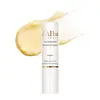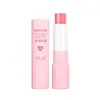What's inside
What's inside
 Key Ingredients
Key Ingredients

 Benefits
Benefits

 Concerns
Concerns

 Ingredients Side-by-side
Ingredients Side-by-side

Petrolatum
EmollientOctyldodecanol
EmollientHelianthus Annuus Seed Oil
EmollientButyrospermum Parkii Butter
Skin ConditioningCeresin
Emulsion StabilisingPolyisobutene
Diisostearyl Malate
EmollientDipentaerythrityl Hexahydroxystearate/Hexastearate/Hexarosinate
Skin ConditioningSynthetic Wax
AbrasiveTuber Magnatum Extract
Skin ConditioningTocopherol
AntioxidantEclipta Prostrata Extract
Skin ConditioningMelia Azadirachta Leaf Extract
Skin ConditioningAdansonia Digitata Fruit Extract
EmollientAnastatica Hierochuntica Extract
AstringentArtemisia Princeps Leaf Extract
Skin ConditioningLeonurus Sibiricus Flower/Leaf/Stem Extract
SoothingHippophae Rhamnoides Fruit Oil
Skin ProtectingCitrus Aurantium Dulcis Oil
MaskingCitrus Nobilis Peel Oil
MaskingLitsea Cubeba Fruit Oil
MaskingMacadamia Ternifolia Seed Oil
EmollientPrunus Amygdalus Dulcis Oil
Skin ConditioningArgania Spinosa Kernel Oil
EmollientPersea Gratissima Oil
Skin ConditioningOlea Europaea Fruit Oil
MaskingOenothera Biennis Oil
EmollientGlycine Soja Oil
EmollientCamellia Japonica Seed Oil
EmollientRosa Damascena Flower Oil
MaskingBetula Platyphylla Japonica Juice
Skin ConditioningCandelilla Wax Esters
Copernicia Cerifera Wax
Moringa Oleifera Seed Oil
EmollientWater
Skin ConditioningButylene Glycol
HumectantCeramide NP
Skin ConditioningCaprylic/Capric Triglyceride
Masking1,2-Hexanediol
Skin ConditioningDehydroacetic Acid
PreservativeLimonene
PerfumingCitral
PerfumingLinalool
PerfumingPetrolatum, Octyldodecanol, Helianthus Annuus Seed Oil, Butyrospermum Parkii Butter, Ceresin, Polyisobutene, Diisostearyl Malate, Dipentaerythrityl Hexahydroxystearate/Hexastearate/Hexarosinate, Synthetic Wax, Tuber Magnatum Extract, Tocopherol, Eclipta Prostrata Extract, Melia Azadirachta Leaf Extract, Adansonia Digitata Fruit Extract, Anastatica Hierochuntica Extract, Artemisia Princeps Leaf Extract, Leonurus Sibiricus Flower/Leaf/Stem Extract, Hippophae Rhamnoides Fruit Oil, Citrus Aurantium Dulcis Oil, Citrus Nobilis Peel Oil, Litsea Cubeba Fruit Oil, Macadamia Ternifolia Seed Oil, Prunus Amygdalus Dulcis Oil, Argania Spinosa Kernel Oil, Persea Gratissima Oil, Olea Europaea Fruit Oil, Oenothera Biennis Oil, Glycine Soja Oil, Camellia Japonica Seed Oil, Rosa Damascena Flower Oil, Betula Platyphylla Japonica Juice, Candelilla Wax Esters, Copernicia Cerifera Wax, Moringa Oleifera Seed Oil, Water, Butylene Glycol, Ceramide NP, Caprylic/Capric Triglyceride, 1,2-Hexanediol, Dehydroacetic Acid, Limonene, Citral, Linalool
Diisostearyl Malate
EmollientCaprylic/Capric Triglyceride
MaskingPolyglyceryl-2 Triisostearate
EmulsifyingOctyldodecanol
EmollientLanolin
EmollientMicrocrystalline Wax
Emulsion StabilisingPolyethylene
AbrasivePolyisobutene
Ceresin
Emulsion StabilisingBis-Diglyceryl Polyacyladipate-2
EmollientPhytosteryl/Isostearyl/Cetyl/Stearyl/Behenyl Dimer Dilinoleate
Skin Conditioning1,2-Hexanediol
Skin ConditioningEthylhexylglycerin
Skin ConditioningTocopheryl Acetate
AntioxidantPhenoxyethanol
PreservativeRosa Canina Fruit Oil
EmollientPrunus Armeniaca Kernel Oil
MaskingPersea Gratissima Oil
Skin ConditioningMacadamia Ternifolia Seed Oil
EmollientButyrospermum Parkii Butter
Skin ConditioningWater
Skin ConditioningButylene Glycol
HumectantPropylene Glycol
HumectantHoney
HumectantHydrogenated Lecithin
EmulsifyingHydrolyzed Collagen
EmollientHydrolyzed Keratin
HumectantHydrolyzed Silk
HumectantHydrolyzed Soy Protein
HumectantCeramide NP
Skin ConditioningCI 15985
Cosmetic ColorantCI 77891
Cosmetic ColorantCI 15850
Cosmetic ColorantCI 19140
Cosmetic ColorantCI 45410
Cosmetic ColorantParfum
MaskingDiisostearyl Malate, Caprylic/Capric Triglyceride, Polyglyceryl-2 Triisostearate, Octyldodecanol, Lanolin, Microcrystalline Wax, Polyethylene, Polyisobutene, Ceresin, Bis-Diglyceryl Polyacyladipate-2, Phytosteryl/Isostearyl/Cetyl/Stearyl/Behenyl Dimer Dilinoleate, 1,2-Hexanediol, Ethylhexylglycerin, Tocopheryl Acetate, Phenoxyethanol, Rosa Canina Fruit Oil, Prunus Armeniaca Kernel Oil, Persea Gratissima Oil, Macadamia Ternifolia Seed Oil, Butyrospermum Parkii Butter, Water, Butylene Glycol, Propylene Glycol, Honey, Hydrogenated Lecithin, Hydrolyzed Collagen, Hydrolyzed Keratin, Hydrolyzed Silk, Hydrolyzed Soy Protein, Ceramide NP, CI 15985, CI 77891, CI 15850, CI 19140, CI 45410, Parfum
Ingredients Explained
These ingredients are found in both products.
Ingredients higher up in an ingredient list are typically present in a larger amount.
1,2-Hexanediol is a synthetic liquid and another multi-functional powerhouse.
It is a:
- Humectant, drawing moisture into the skin
- Emollient, helping to soften skin
- Solvent, dispersing and stabilizing formulas
- Preservative booster, enhancing the antimicrobial activity of other preservatives
Butylene Glycol (or BG) is used within cosmetic products for a few different reasons:
Overall, Butylene Glycol is a safe and well-rounded ingredient that works well with other ingredients.
Though this ingredient works well with most skin types, some people with sensitive skin may experience a reaction such as allergic rashes, closed comedones, or itchiness.
Learn more about Butylene GlycolThis ingredient is also known as shea butter. It is an effective skin hydrator and emollient.
Emollients help soothe and soften your skin. It does this by creating a protective film on your skin. This barrier helps trap moisture and keeps your skin hydrated. Emollients may be effective at treating dry or itchy skin.
Shea butter is rich in antioxidants. Antioxidants help fight free-radicals, or molecules that may harm the body. It is also full of fatty acids including stearic acid and linoleic acid. These acids help replenish the skin and keep skin moisturized.
While Shea Butter has an SPF rating of about 3-4, it is not a sunscreen replacement.
Shea butter may not be fungal acne safe. We recommend speaking with a professional if you have any concerns.
Learn more about Butyrospermum Parkii ButterThis ingredient is an emollient, solvent, and texture enhancer. It is considered a skin-softener by helping the skin prevent moisture loss.
It helps thicken a product's formula and makes it easier to spread by dissolving clumping compounds.
Caprylic Triglyceride is made by combining glycerin with coconut oil, forming a clear liquid.
While there is an assumption Caprylic Triglyceride can clog pores due to it being derived from coconut oil, there is no research supporting this.
Learn more about Caprylic/Capric TriglycerideCeramide NP is a type of ceramide and formally known as ceramide 3.
Ceramides are intercellular lipids naturally found in our skin that bonds dead skin cells together to create a barrier. They are known for their ability to hold water and thus are a great ingredient for dry skin.
Ceramides are an important building block for our skin barrier. A stronger barrier helps the skin look more firm and hydrated. By bolstering the skin ceramides act as a barrier against irritating ingredients. This can help with inflammation as well.
If you would like to eat ceramides, sweet potatoes contain a small amount.
Read more about other common types of ceramides here:
Ceramide AP
Ceramide EOP
Ceresin is a wax derived from ozokerite. It is an alternative to beeswax.
The most common process of creating ceresin is by using heat and sulfuric acid.
Diisostearyl Malate is an emollient and most often used in lip products. It comes from isostearyl alcohol, a fatty acid, and malic acid, an AHA.
As an emollient, Diisostearyl Malate helps create a thin film on your skin to trap moisture in. This helps keep your skin soft and smooth.
Macadamia Ternifolia Seed Oil is the fixed oil obtained from Macadamia nut.
Macadamia seed oil is rich in fatty acids, including oleic acid (45-75%), palmitoleic acid (7-33%), and palmitic acid (6-12%). They also contain various B vitamins, iron, and magnesium.
Palmitoleic acid has been shown to help soothe inflammation and promote wound healing. It is also naturally found in the fat of our skin.
Macadamia seed oil may not be malassezia folliculitis, or fungal-acne, safe.
Learn more about Macadamia Ternifolia Seed OilOctyldodecanol is a fatty alcohol. It is primarily used to enhance the texture of products.
As an emulsifier, Octyldodecanol helps prevent the oils and waters from separating. It also prevents ingredients from creating foam when shaken.
Octyldodecanol is created by reducing fatty acid to an alcohol.
Due to its high molecular weight, it does not get absorbed into the skin.
Learn more about OctyldodecanolPersea Gratissima Oil is also known as avocado oil.
Avocado Oil has antioxidant properties. It is mostly made up of the glycerides of fatty acids. About 67% of these fatty acids is made up of oleic acid. Palmitic acid and linoleic acid are also present.
These fatty acids help hydrate and soften the skin. It may increase collagen content in the skin. Collagen helps keep your skin plump and firm. This ingredient helps reduce inflammation and has not shown to clog pores.
This ingredient may not be fungal-acne safe due to its high fatty acid content.
Avocados also have B vitamins, vitamin K, vitamin C, vitamin E, and potassium.
Learn more about Persea Gratissima OilPolyisobutene is a synthetic polymer made from isobutene.
It is a film-forming agent and helps bind ingredients together.
Polyisobutene is not absorbed by the skin.
Learn more about PolyisobuteneWater. It's the most common cosmetic ingredient of all. You'll usually see it at the top of ingredient lists, meaning that it makes up the largest part of the product.
So why is it so popular? Water most often acts as a solvent - this means that it helps dissolve other ingredients into the formulation.
You'll also recognize water as that liquid we all need to stay alive. If you see this, drink a glass of water. Stay hydrated!
Learn more about Water